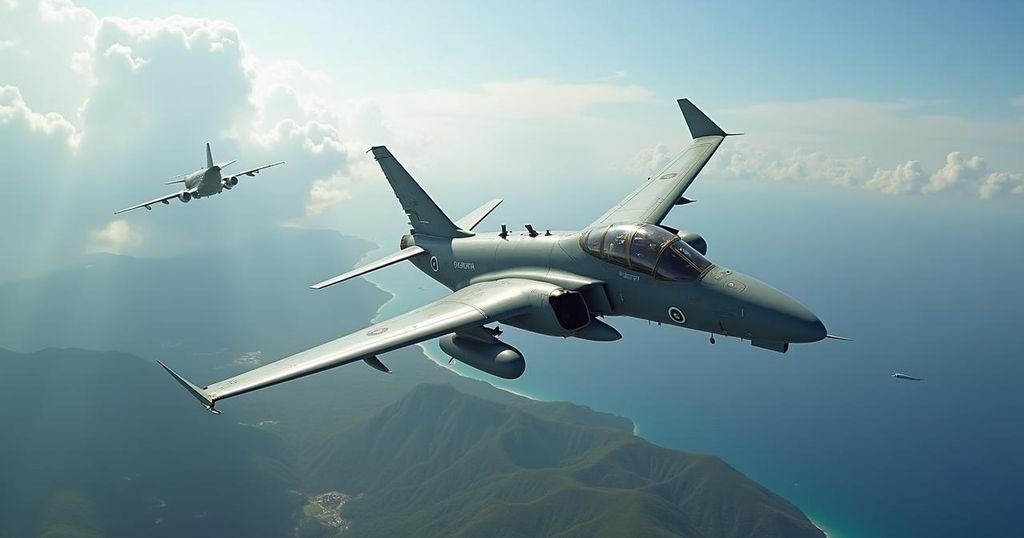U.S. and Philippines Commence Military Exercises Amid Rising Tensions with China
The joint military exercises termed Kamandag began involving U.S. and Filipino troops as tensions escalate with China conducting exercises near Taiwan, which was observed to have a record number of Chinese military aircraft. The drills focus on defending Luzon and are part of broader efforts to enhance responses to potential crises linked to ongoing maritime disputes in the South China Sea, following recent confrontations between Chinese and Philippine vessels.
On Tuesday, the United States and the Philippines commenced extensive joint military exercises in the northern and western regions of the Philippines, driven by escalating tensions in the area. This initiative was launched subsequent to large-scale military drills executed by China around Taiwan and a collision involving a Chinese vessel and a Filipino patrol boat. In conjunction with these exercises, Taiwan reported a significant escalation of military activity, having observed a record 153 Chinese military aircraft in its vicinity within a 25-hour timeframe, marking the highest daily count noted thus far. The annual military drills, referred to as Kamandag, which translates to ‘Venom,’ prioritize the defense of Luzon, the primary island of the Philippines positioned approximately 500 miles away from Taiwan. In this context, Beijing asserts its claim over Taiwan, considering it as integral to its territory, and has declared that military action remains a possibility to reclaim it. China regarded its recent maneuvers as a stringent warning directed towards what it perceives as separatist elements within Taiwan. Taiwan’s administration has rebuffed these actions from China, labeling them as “irrational and provocative,” while the United States expressed its disapproval, calling the operations “unwarranted.” Major General Pat Ryder, the spokesperson for the Pentagon, described China’s military pressure as “irresponsible, disproportionate, and destabilizing.” The commencement of the U.S.-Philippine exercises closely followed the aforementioned maritime incident between a Chinese and a Philippine vessel in the South China Sea, further highlighting the ongoing territorial disputes in the area, which China claims almost exclusively. Major General Arturo Rojas of the Philippine Marine Corps emphasized that the Kamandag exercises had been pre-planned and were not a reaction to current tensions in the region. The focal point of the drills will be live-fire exercises along the northern coastline of Luzon, in addition to activities on smaller Philippine islands situated between Luzon and Taiwan. Brigadier-General Vicente Blanco, the director of the exercises, clarified, “We are not exercising to join the fight (over Taiwan).” U.S. representatives also indicated that the drills are geared towards enhancing cooperative responses to potential crises or contingencies. Approximately 1,000 personnel from both the U.S. and the Philippines are participating in this military collaboration, alongside smaller contingents from Australia, Britain, Japan, and South Korea. As the exercises unfolded, the Philippine government announced that the BRP Datu Cabaylo, a civilian patrol vessel, had recently sustained minor damage as a result of being “deliberately sideswiped” by a Chinese maritime militia vessel, approximately 5.8 miles away from Thitu, a Philippine-occupied island within the Spratly archipelago. Incidents of this nature have increased, with multiple clashes reported between Chinese vessels and Filipino ships over the past two years, as China continues to assert its dominance in disputed waters while disregarding international rulings that challenge its claims. This pattern of aggressive behavior underscores China’s intent to fortify its influence in strategically significant regions of the South China Sea.
The article discusses the elevated military tension in East Asia, particularly involving the United States, the Philippines, and China, over issues surrounding Taiwan and the South China Sea. The U.S. and Philippine military exercises, known as Kamandag, are part of a broader strategy to enhance defense capabilities in response to the perceived threats from China, which views Taiwan as an integral part of its territory. Additionally, the ongoing disputes in the South China Sea complicate the regional security dynamics as China expands its maritime presence and cooperates with the Philippine Islands, creating additional friction with other regional powers and the Philippines themselves.
In conclusion, the commencement of the joint military exercises between the United States and the Philippines reflects significant geopolitical tensions in the region, specifically regarding China’s growing military presence and assertive actions towards Taiwan and within the South China Sea disputes. As both nations strengthen their defensive postures, the global community continues to monitor these developments carefully, as they hold implications for regional stability and international relations.
Original Source: www.cbsnews.com








Post Comment